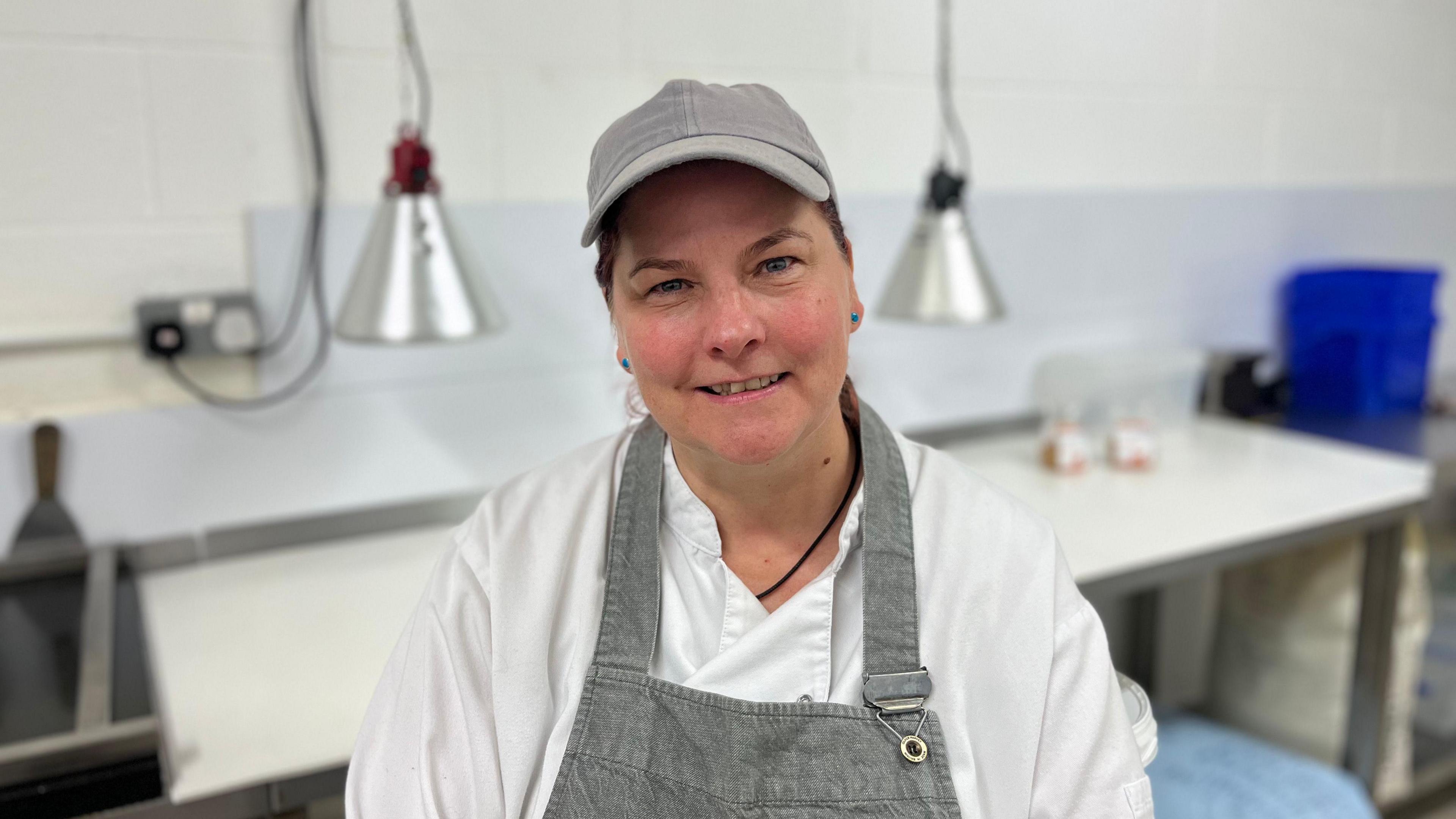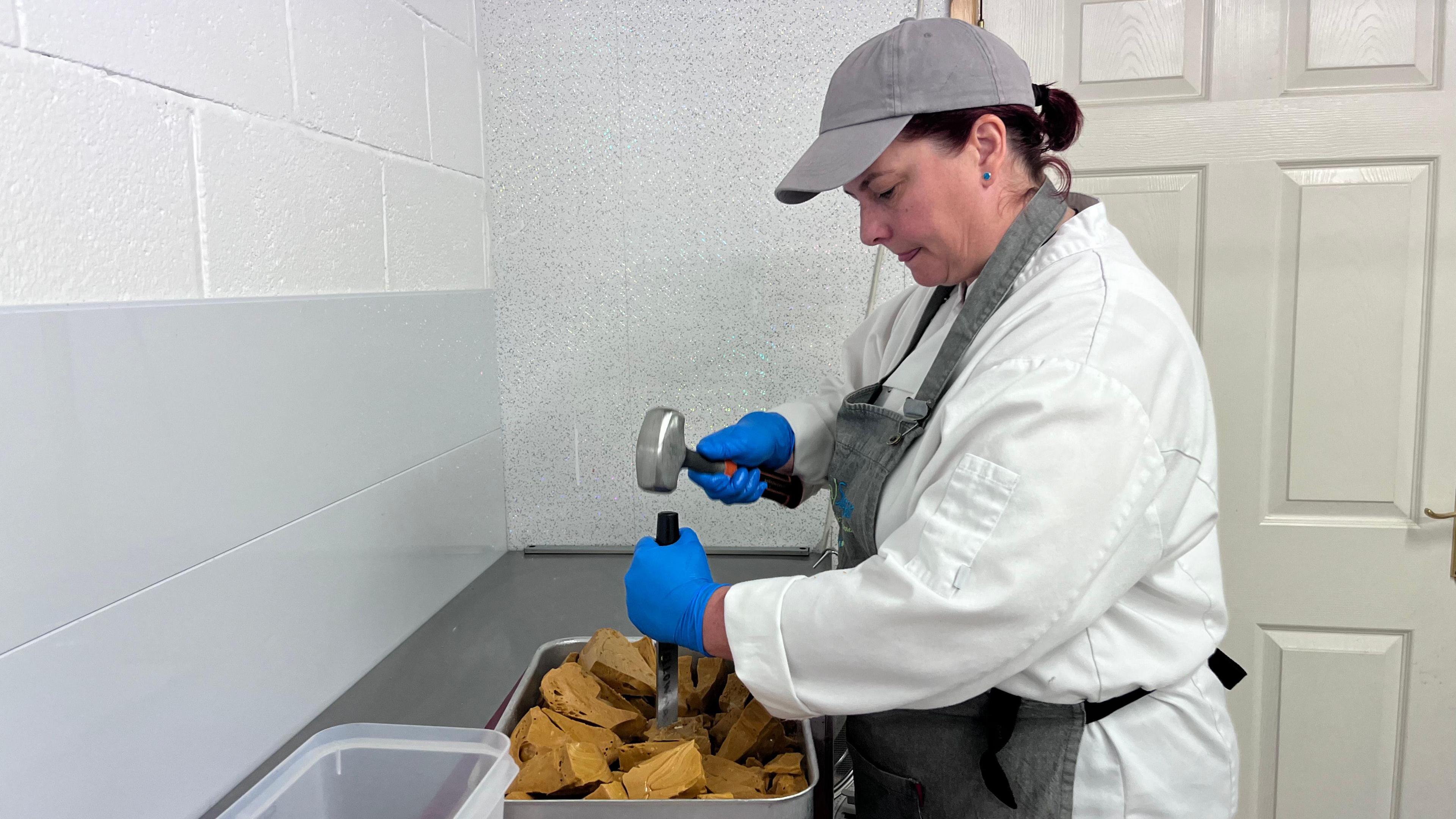Yellowman - the traditional sweet treat with a secret recipe

Yellowman is a familiar sight at the fair in Ballycastle each year
- Published
Have you heard of the Northern Irish sweet with an original secret recipe known only by three families and sold at a local market in August each year?
Introducing - yellowman.
It is a unique rock-like sweet, its history shrouded in mystery and its origins up for debate.
The treat is near-exclusively tied to the Ould Lammas Fair, an event which has been held in the last week of August in Ballycastle since the 17th Century.
The annual event attracts thousands to Northern Ireland's north coast over the bank holiday, which traditionally marked the end of summer and the beginning of harvest.
Ould Lammas Fair: 'I could break my teeth on Yellowman'
For decades the Devlin, McKeown and Agnew families from Ballymena, County Antrim, were central to yellowman production.
John Devlin believes his grandfather, Joe Devlin, is responsible for naming the confectionery and bringing it to the fair in the early 1900s. His aunt also appears in the archive video included in this article.
It provided another form of income for the three families who were primarily fruit sellers, he told BBC News NI.
"We (the families) were all related someway, and they all had the one ingredient that none of the rest had or have.
“From early August, it was seven days a week. There were no summer holidays, it was just making yellowman for the Lammas Fair,” he recalled.

John Devlin holds the famous 'Devlin recipe' for yellowman
“The main ingredient was syrup which had to be boiled in huge black pots, plus other ingredients which I am forbidden to say," he joked.
"When cooled down, the ingredients were pulled over large hooks by hand until it turned a whitish colour," he added.
The Broughshane man has fond memories working alongside his family, including his father Archie who used to sign the bags.
"I never got that high up in the pecking order, but I got the privilege of breaking it,” he said.
“Anytime I return to Ballycastle and I drive through the Diamond I can always see the stalls. Sadly, the ‘old timers’ are all gone,” he added.

Peter Molloy from Ballycastle is a founding member of Friends of Ballycastle Museum
Local historian Peter Molloy has been attending the fair since he was a child.
He said for some the Ould Lammas Fair was a bigger event than Christmas.
But where does the association with yellowman originate?
Much like the origin of the fair itself, Mr Molloy said the story is shrouded in some mystery and much has been passed on by mouth, rather than written record.
He believes the ingredients were locally sourced and developed, leading to its fame as a Ballycastle delicacy.
Word of yellowman was also spread through the traditional song 'The Ould Lammas Fair', which references the sweet in the lyrics: "Did you treat your Mary Ann to some Dulse and Yellow Man? At the ould Lammas Fair in Ballycastle-O."
Mr Molloy recalls the three families from Ballymena selling the 'traditional' yellowman. For him "the vivid yellow colour" version of the candy isn't the same.
Traditional versus modern yellowman
While neither of the three families are currently involved in the production of yellowman, the popularity and demand for the sweet has led to new producers trying to re-create the sweet from their own family recipes.
Linda McGibbon, owner of SeaSugar Handmade Confectionery, is a modern producer of yellowman for stalls at the Ould Lammas Fair.
“It is a hard rock-like confection not to be confused with honeycomb which is light, airy and melt in the mouth," she explained.
"It will break into shards the way that honeycomb never would."
Having previously been a stall holder herself she said the “nostalgic taste” is a huge factor in its continued popularity.

Linda produces “kilos and kilos and kilos” of the famous yellowman for the Ould Lammas Fair
“It sells like crazy! I always sold out," she said.
"I could never bring enough yellowman to the Lammas Fair."
Having inherited the recipe from her grandmother she felt duty-bound to share the “authentic taste” with the public.
She believes her yellowman, which is golden in colour, is representative of the traditional version sold decades ago.
For younger customers this can cause some confusion as most modern yellowman has evolved into a bright yellow confection.
‘We need to cherish it and shout about it’

Linda said it is a privilege to supply her granny's yellowman to the fair and keep the tradition alive.
Ms McGibbon uses traditional methods with a hammer and chisel, completing the “lengthy, time consuming and physical” process, her latest spread over two days.
“Yellowman is unique to Northern Ireland and within that County Antrim," she continued.
"We need to cherish it, hold on to it and shout about it," she said.
"We don't make enough of our own food heritage and yellowman is part of that."